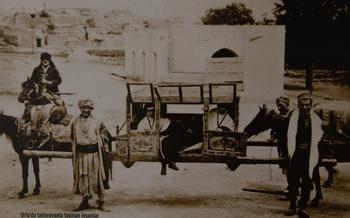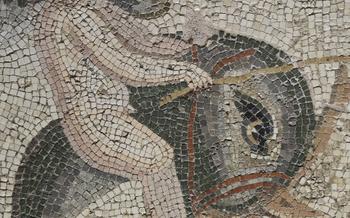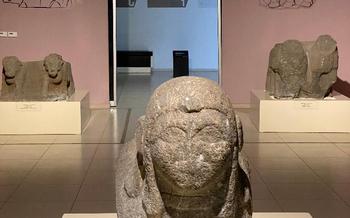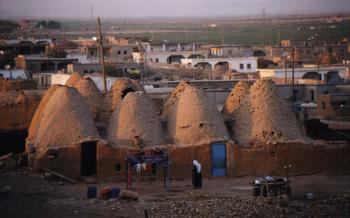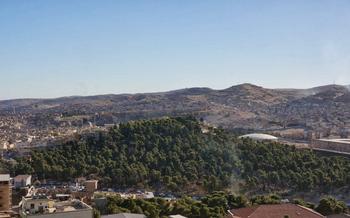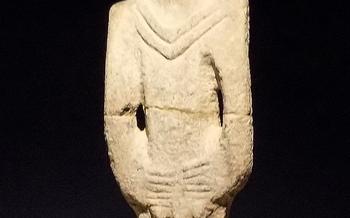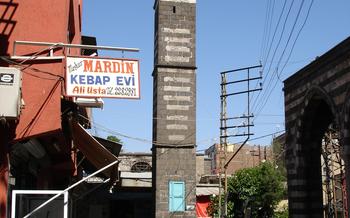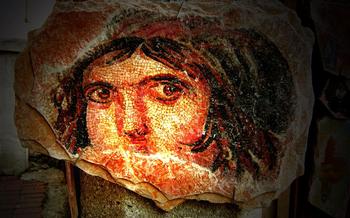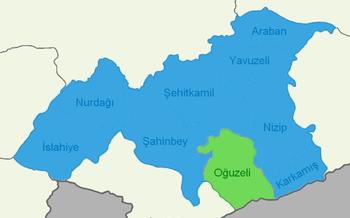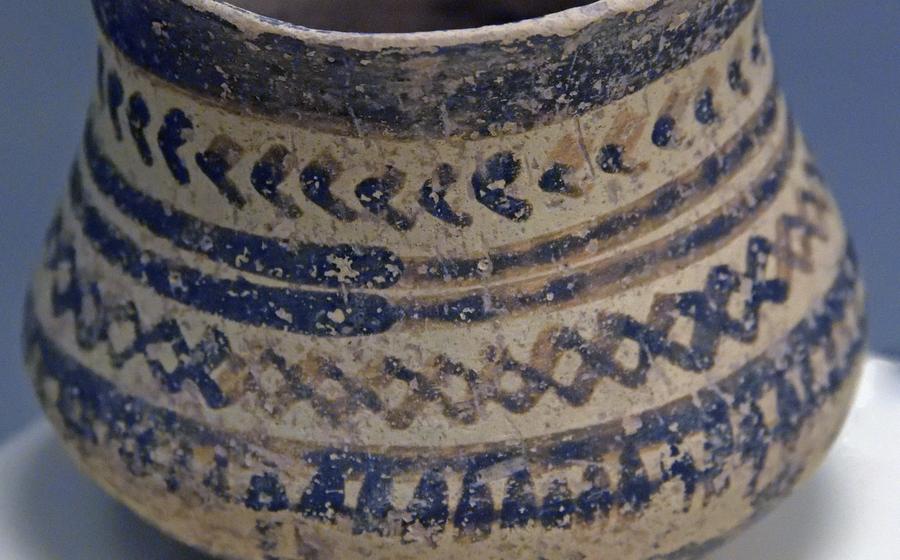
Kazane Höyük
- History of Kazane Höyük:
- Location of Kazane Höyük:
- Excavations and Discoveries
- Unique Features of Kazane Höyük
- Museum of Şanlıurfa: A Treasure Trove of Ancient History
- Best Time to Visit
- Duration of Visit:
- Attire and Footwear:
- Food and Drinks
- Guided Tours
- Photography and Videography
- Accessibility
- Local Customs and Traditions
- Nearby Attractions
- Insider Tip:
History of Kazane Höyük:
In the heart of ancient Mesopotamia, nestled along the banks of the Euphrates River, lies Kazane Höyük, a site that has captured the fascination of archaeologists and history enthusiasts alike. Its origins stretch back to the dawn of civilization, dating back to the prehistoric era, when the first human settlements emerged in this fertile crescent. Excavations at Kazane Höyük have revealed evidence of continuous habitation from as early as 11,000 BC, making it one of the earliest known settlements in the region. Over the centuries, various civilizations have left their mark on Kazane Höyük, from the Neolithic era to the Hellenistic and Roman periods. Each layer of history adds to the rich tapestry of this ancient site, providing invaluable insights into the evolution of human societies and cultural interactions in this pivotal region.
Location of Kazane Höyük:
Kazane Höyük is situated at the geographical coordinates of 37°17'03"N 38°52'50"E. The site is located approximately 15 kilometers northwest of the city of Şanlıurfa, in southeastern Turkey. It lies in close proximity to the ancient city of Harran, another significant archaeological site in the region.
To reach Kazane Höyük, visitors can take public transportation or drive their own vehicles. From Şanlıurfa, there are regular buses and minibuses that depart from the city center and stop near the site. For those driving, the site is accessible via well-maintained roads.
The entrance fee to Kazane Höyük is relatively nominal, and the site is open to visitors daily from 8:00 AM to 5:00 PM. Visitors are advised to check the official website or contact the local tourism office for the most up-to-date information on entrance fees and visiting hours.
Excavations and Discoveries
Kazane Höyük has undergone extensive archaeological excavations since its discovery in the early 20th century. These excavations have uncovered a treasure trove of artifacts, providing valuable insights into the lives and culture of the ancient inhabitants of the site. Among the most significant findings are well-preserved remnants of Neolithic houses, complete with hearths, storage pits, and ovens. These structures offer a glimpse into the domestic life of the early settlers.
The excavations have also unearthed a variety of tools and implements, including stone tools, bone tools, and ceramic vessels. These artifacts shed light on the technological advancements and daily activities of the ancient inhabitants. Additionally, the discovery of numerous animal bones and plant remains has provided valuable information about the subsistence strategies and diet of the prehistoric community.
Perhaps the most intriguing discovery at Kazane Höyük is a series of large, circular structures known as "tholos" buildings. These structures, believed to have been used for ritual or ceremonial purposes, feature unique architectural elements and intricate decorations. The discovery of these tholos buildings has significantly contributed to our understanding of the religious and cultural practices of the Neolithic period in the region.
Unique Features of Kazane Höyük
Kazane Höyük stands out for its distinctive architectural features, reflecting the ingenuity and resourcefulness of its ancient inhabitants. The site's monumental structures, including temples and fortifications, showcase the advanced construction techniques of the time. The fortifications, with their imposing walls and towers, served as a protective barrier against potential threats.
The site's water management system is another remarkable feature. The ancient inhabitants of Kazane Höyük developed a sophisticated network of canals, reservoirs, and underground channels to ensure a reliable water supply for the settlement. This system played a crucial role in sustaining the community and allowed for agricultural activities to flourish.
Kazane Höyük is also rich in cultural and religious artifacts, providing valuable insights into the beliefs and practices of its inhabitants. Sculptures, pottery, and inscriptions unearthed during excavations shed light on the artistic expressions and religious symbolism of the ancient civilization. The site's significance as a center of trade and cultural exchange is evident from the presence of imported goods and cultural influences from neighboring regions.
The unique features of Kazane Höyük, combined with its historical importance, make it a captivating destination for history enthusiasts, archaeologists, and anyone interested in exploring the roots of civilization in Mesopotamia.
Museum of Şanlıurfa: A Treasure Trove of Ancient History
To delve deeper into the history and culture of the region, a visit to the Museum of Şanlıurfa is a must. This world-renowned museum houses a remarkable collection of artifacts excavated from Kazane Höyük and other archaeological sites in the region. As you wander through the museum's galleries, you'll be transported back in time as you admire intricate sculptures, pottery, and inscriptions that tell the story of ancient civilizations that once flourished in this land.
The museum's exhibits are meticulously curated to showcase the rich cultural heritage of Mesopotamia. From the earliest Neolithic settlements to the rise of powerful empires, the museum takes you on a journey through the ages. Among the highlights of the collection are the iconic Balıklıgöl Statues, dating back to the 9th century BC, which depict a procession of gods and goddesses.
A visit to the Museum of Şanlıurfa is an essential complement to your exploration of Kazane Höyük. Here, you'll gain a deeper understanding of the significance of the site and its role in the development of human civilization.
Best Time to Visit
The ideal time to visit Kazane Höyük is during the spring (April-May) or fall (September-October) when the weather is generally pleasant and mild. During these seasons, visitors can comfortably explore the site without having to endure extreme heat or cold. The spring months offer the added bonus of witnessing the surrounding landscape in full bloom, creating a picturesque backdrop for your visit.
Summer (June-August) can be very hot and dry in the region, with temperatures often exceeding 40 degrees Celsius. While the site does provide some shade, it's important to take precautions against the heat, such as wearing light clothing, bringing a hat and sunglasses, and staying hydrated.
Winter (November-March) can be cold and rainy, with occasional snowfall. While the site remains open during this time, some areas may be inaccessible due to weather conditions. It's advisable to check the weather forecast before planning a visit during the winter months.
Duration of Visit:
Exploring Kazane Höyük can be comfortably accomplished within a few hours, making it an ideal destination for a half-day trip. This duration allows visitors to thoroughly explore the site's key features, including its ancient structures, fortifications, and artifacts, without feeling rushed. To enrich your experience, consider combining a visit to Kazane Höyük with other nearby attractions in the region, such as Göbekli Tepe or Harran. This approach provides a comprehensive immersion into the rich history and cultural heritage of Şanlıurfa. If you have a particular interest in archaeology or ancient civilizations, allocate more time to delve deeper into the site's significance and uncover its hidden stories.
Attire and Footwear:
When visiting Kazane Höyük, it's essential to dress comfortably and appropriately. The uneven terrain and extensive walking require sturdy footwear, such as hiking boots or sneakers, to ensure a safe and enjoyable experience. Respecting local customs and traditions, modest clothing is recommended, especially for women. Visitors should consider bringing a hat or scarf to protect themselves from the sun or cold weather and a small backpack or bag to carry water, snacks, and other essentials.
Food and Drinks
Unlike many modern tourist attractions, Kazane Höyük does not offer any on-site dining options. Visitors are advised to come prepared with their own food and drinks, as there are no restaurants or cafes within the site itself. A packed lunch or some snacks will ensure that you can refuel and stay energized throughout your visit.
If you prefer to sample the local cuisine, the nearby city of Şanlıurfa offers a range of restaurants serving traditional Turkish dishes. From freshly grilled kebabs to savory pide bread and flavorful stews, there's something to satisfy every palate. Don't miss the chance to try some of the region's specialties, such as çiğ köfte (raw meatballs) or the famous Şanlıurfa kebab.
Staying hydrated is essential, especially during the hot summer months. Bring a reusable water bottle and fill it up at one of the water fountains located near the entrance of the site. Remember, there are no shops or vending machines within Kazane Höyük, so it's important to be self-sufficient in terms of food and drinks.
Guided Tours
To fully immerse yourself in the history and significance of Kazane Höyük, consider booking a guided tour. Professional guides can provide valuable insights, explanations, and anecdotes that enhance your understanding of the site. Various tour operators offer guided tours, both private and group, catering to different interests and group sizes.
Private tours offer a more personalized experience, allowing you to customize the itinerary and receive undivided attention from your guide. Group tours, on the other hand, provide an opportunity to interact with fellow travelers and share experiences.
Booking a guided tour in advance is recommended to secure your spot, especially during peak tourist season. Tour operators typically provide detailed information about pricing, availability, and meeting points on their websites or through direct contact.
With a knowledgeable guide leading the way, you'll gain a deeper appreciation for the ancient wonders of Kazane Höyük and leave with a lasting impression of this remarkable site.
Photography and Videography
Photography and videography are generally permitted at Kazane Höyük for personal use. However, it is essential to be respectful of other visitors and the site's environment when capturing images. Using a tripod or monopod is recommended to avoid camera shake and capture steady shots. Flash photography is generally not allowed inside the museum to protect the artifacts from damage. Visitors are also advised to avoid taking photos or videos of people without their consent. By adhering to these guidelines, visitors can ensure that they capture memorable images of their experience while respecting the site's rules and regulations.
Accessibility
Kazane Höyük is committed to providing an inclusive and accessible experience for all visitors. The site features paved pathways and ramps throughout, making it easy for wheelchair users and visitors with limited mobility to navigate the ancient ruins. However, it is important to note that some areas of the site may still present challenges for visitors with disabilities.
For those requiring additional assistance, it is recommended to contact the site's administration in advance. The staff is well-equipped to provide guidance and support, ensuring that all visitors have a safe and enjoyable experience. Whether you are exploring the ancient ruins independently or with a guided tour, Kazane Höyük offers an accessible and immersive journey into the past.
Local Customs and Traditions
When visiting Kazane Höyük, it is essential to be mindful of local customs and traditions to ensure a respectful and enjoyable experience. Dressing modestly and behaving appropriately is expected, as the site holds cultural and religious significance. Photography and videography may be restricted in certain areas or situations, so it is advisable to seek permission before taking photos or videos. Learning a few basic Turkish phrases can be helpful for communicating with locals and showing respect for the local culture. Remember that Turkey is a predominantly Muslim country, so observing local customs and traditions is a sign of respect and appreciation for the local way of life.
Nearby Attractions
Kazane Höyük is located in a region rich in historical and cultural attractions. Visitors can easily combine their visit with other nearby sites to create a comprehensive itinerary.
One of the must-see attractions is Göbekli Tepe, located just 30 kilometers from Kazane Höyük. This ancient temple complex is believed to be the oldest in the world, dating back to around 10,000 BC. Its massive stone pillars and intricate carvings offer a glimpse into the earliest known religious practices.
Another nearby attraction is the ancient city of Harran, located around 45 kilometers from Kazane Höyük. Harran is known for its unique beehive-shaped houses, which have been inhabited continuously for centuries. Visitors can explore the city's narrow streets and marvel at the traditional architecture.
For those interested in Roman history, the Zeugma Mosaic Museum in the nearby city of Gaziantep is a must-visit. This museum houses a collection of stunning Roman mosaics that were excavated from the ancient city of Zeugma. The mosaics depict scenes from mythology, history, and everyday life, offering a glimpse into the culture and artistry of the Roman Empire.
To make the most of your trip, consider creating an itinerary that allows you to visit multiple attractions in the region. Transportation options between these attractions are readily available, making it easy to explore the rich history and culture of southeastern Turkey.
Insider Tip:
- Explore the site at sunrise or sunset for captivating photo opportunities: Kazane Höyük offers stunning views, especially during the golden hours of sunrise and sunset. Take advantage of this magical lighting to capture breathtaking photos of the ancient ruins against the backdrop of the vibrant sky. The warm hues will enhance the textures and colors of the site, creating a picturesque scene that will leave you in awe.
